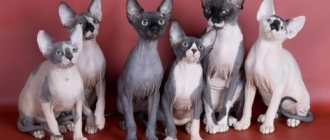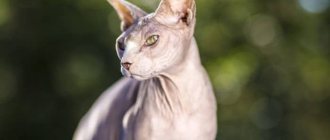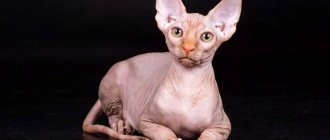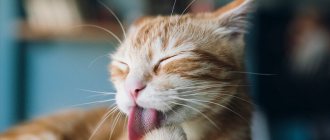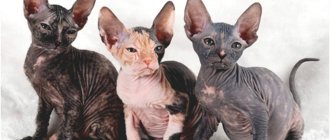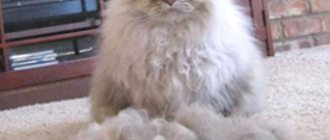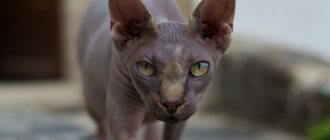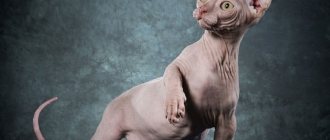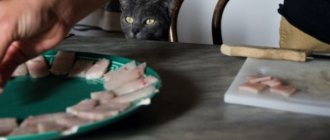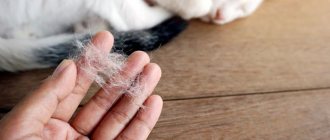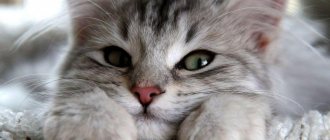Article navigation
Varieties of the Don breedVelor SphynxBrush SphynxFlock Sphynx Description of what it looks like and what colors there are Differences between the Canadian, Don and St. Petersburg SphynxesCharacter and special habits of the BrushSphynxHow to care for the Don SphynxCharacterHow to toilet train a SphynxRules for bathing a SphynxCharacter and behaviorPhoto gallery: Sphynxes live next to us - interesting factsWhy sphinxes have fur ?Sphinxbrush of the Don breedPetersburgbrush (Peterbald)Health How long do they live? Breeding the breedHow to choose a kittenTypes of coat of sphinxesFlockVelourBrushStraight-hairedHealth and susceptibility to diseases What to look for when choosing Prices for kittensPros and cons
Description of what it looks like and what colors there are
Any colors of the Don Sphynx are allowed, except lilac and chocolate. There are purebred Donchak dogs:
- white;
- black;
- gray;
- red;
- blue;
- red;
- pinkish.
Tabby-colored cats (patterned, striped) are also recognized by the felinological community, but they are classified into a separate subgroup, without division by pattern.
And here you will find the schedule of WCF cat shows for 2020.
The history of breeding velor sphinxes
All types of hairlessness of the Don and St. Petersburg Sphynxes are based on the dominant Hbl gene, which determines the main characteristics of these breeds and their breeding. Velor wool covering is one of the most popular - it looks impressive and does not create big problems in maintenance.
Velor Sphynx kitten is an incredibly charming creature
Don Sphynx velor
The Varvara cat, with whom the Don Sphynx breed is believed to have begun, was velor-point according to the modern classification of coat and blue-cream “tortoise” according to the color type. This strange kitten was taken from the boys on the street by Rostov resident Elena Kovaleva in 1986 - and at that very moment she entered the history of felinology. She was very sorry for the “shabby” baby and tried to fatten her and cure her. The cat grew up and felt great, but there was even less hair on her.
Varvara's children also had a velor covering; a baby named Chita attracted the attention of Elena’s friend Irina Nemykina, who later became the founder of the Don Sphynx breed, making titanic efforts to develop and recognize it. The new breed was recognized by the WCF in 1998, after which it received recognition from other felinological organizations around the world. Until 2000, matings with Siberian and European shorthair cats were allowed.
This is what the modern Don Sphynx looks like
The Donchaks have several breed standards, the differences of which are insignificant. Velor Don Sphynxes are characterized by hot, wrinkled skin with a delicate coat of hair that creates a small collar around the head. Young animals may have excessive hair. In winter, the growth also increases. The vibrissae are convoluted and break off easily.
The WCF and SFF standards allow all colors, while the IFF standard prohibits lilac and chocolate. The colors of the eyes, nose and fingertips should be in harmony with the main color.
Velor Peterbald
In the group of sphinxes, this breed is the youngest; it was the result of interbreeding of Donchak with Orientals, which gave its representatives a unique appearance. The first experimental mating took place in 1994, and the offspring lived up to the wildest hopes - excellent material was obtained for further selection. Today, interbreed matings between St. Petersburg and Don Sphynxes are prohibited. The breed received international recognition from the WCF in 2003.
The Peterbald's elegant appearance contributes greatly to its popularity.
The WCF standard allows any colors for St. Petersburg Sphynxes, but the preferred eye color is green, and in color-point varieties - blue. The skin of a velor Peterbald is flexible, very delicate, the quality of wool velor is the same as that of the Don Chaks; The presence of vibrissae is highly desirable. The color of the finger pads and nose should be in harmony with the main color.
Character and special habits of brushes
These cats can be characterized as playful and inquisitive. Over time, they become full-fledged members of the family. They choose one master or favorite for themselves, they always obey him unquestioningly, carrying out all his commands. They treat other people with warmth and good nature. Also, the Sphynx Brush is intelligent, but tends to be touchy. However, he is not vindictive. You should not punish this animal physically and psychologically.
Brushes can be called empaths, capable of sensing changes in a person’s mood. They react to this, trying to pity and cheer up the person. Cats love affection, all kinds of manifestations of tenderness, care, and attention to themselves. This breed is characterized by quickly getting used to a new place, observing all the requirements that the owners place on them. If the animal refuses to visit the tray assigned to it, you just need to move it to another place.
Sphynx kittens.
Character
Velor beauties are very affectionate
Don Sphynxes are friendly cats. These are companions who are happy to spend time next to people: they love to lie on the couch with their owner, and run after a person around the apartment. Purrs, as sociable animals, find it sad to be alone for a long time. They are loyal, non-aggressive, but can be offended if the owner swears loudly.
The tailed cats of this breed are comfortable with living with dogs and other medium-sized pets. In addition, they get along with children: they are ready to play with kids and do not scratch. Animals are especially active when they are young. Adult cats prefer a quiet rest, but sometimes they are not averse to frolic.
Don Sphynxes are distinguished by their intelligence. They can be trained. But at the same time, you cannot roughly force the animal to obey, otherwise the pet will become stubborn. It is better to use the reward method - for each execution of a command you need to treat the cat with a treat. Hairless purrs can learn different tricks. Tailed animals are able to understand the requirements to “sit” and “lie down”. They love to fetch the ball.
The character of the Don Sphynx
In the body of this alien creature hides a very vulnerable soul, yearning for close emotional contact with its owner. So the correct Don Sphynx is unusually soft (as soft as a representative of the cat family can be), not at all jealous and absolutely not prone to aggression. Anyone can offend this good-natured big-eared dog, but no one can make him angry, which makes “Donetsk” dogs ideal pets for families where young tomboys are growing up.
Meek and loving, the Don Sphynx is always happy to receive “calf tenderness,” but if the owner is not yet ready for an open manifestation of feelings, it is not a sin to push him a little. There are a lot of ways to do this, and Rostov cats have mastered almost all of them. In particular, any unoccupied knees in the house will certainly be tested by the Donetsk team for softness and elasticity, and their owner will be caressed to the point of semi-consciousness. At the same time, bald purrs do not suffer from excessive clinginess and do not try to impose their company on someone who does not need it.
In general, Don Sphynxes are moderately lazy creatures, equally willing to devote their free time to both standard cat pranks and lying on radiators. In childhood, they show strong curiosity and activity, but as they grow up, they become somewhat fed up with new impressions and look at life with slight indifference. The peacefulness and non-conflict nature of the breed is already a cliché, so feel free to release parrots, hamsters, guinea pigs and other representatives of the feathered and fluffy world from their cages - the Don Sphynx has nothing to do with them.
It is generally accepted that, intellectually, the “Donetsk people” are somewhat superior to their “woolen” relatives. Indeed, they are incredibly smart and savvy. For example, almost any adult cat knows how to deal with a door latch (long fingers, like those of an alien from an American blockbuster, come in handy here). In addition, they have excellent intuition: the Don Sphynx is always aware of when it is possible to cuddle with its owner, and when it is better to move away so as not to provoke the two-legged master to anger.
How to toilet train a Sphynx
Sphynxes are clean animals and are easily litter trained. If your pet ignores the toilet, it means he doesn’t like something. Try choosing a different tray or experiment with fillers. Do not use physical force or scold your pet during training.
Do not miss
- Do not miss
How to train a kitten to use a litter box in an apartment: step-by-step instructions
It is not recommended to use silica gel filler: the baby may accidentally swallow the “balls” and get poisoned. Life hack: before pouring the filler, place the bag on the tray - this way the plastic will not absorb the smell. During cleaning, collect the film and throw the granules into the trash.
Rules for bathing a sphinx
Hairless cats love bath treatments. The optimal water temperature is 36-38 degrees.
How to bathe a Sphynx:
- There is a rubberized mat at the bottom of the bed bath to prevent your pet's paws from slipping.
- Use special products for washing hairless cats, and make sure that the liquid does not get into the eyes and ears.
- After the bath, dry the kitten with a soft towel, take it to a warm place or cover it with a blanket.
- Do not dry your pet with a hairdryer - dry and hot air can burn the delicate skin.
Character and behavior
Owners of “bald cats” are convinced that their pets have the highest level of intelligence among domestic cat breeds - it is quite possible that this is so. All Sphynx cats are very affectionate and affectionate cats. They are dog-oriented and interested in their owner, they train well and explore the world around them with great curiosity.
The Sphinx cannot imagine her life without her beloved owner
Loneliness is not for them, keep this in mind if you are planning to get a Sphynx. Donchak dogs are more self-confident and, at least for a short time, will be able to find something to do to pass the time while waiting for the owner. Canadians are very sensitive, withdrawn and fixated on their rich inner world - being left without an owner, they suffer greatly. Peterbalds are emotional, active and will constantly “tell” you about all their activities and fun.
These cats are bright, unique personalities, and this certainly has nothing to do with the type of coat they have. Much more important is whether you can find mutual understanding with them - then your life will become more interesting and sparkle with new colors.
Photo gallery: sphinxes live next to us - interesting facts
They are friends with pets and seem to consider themselves a little like dogs. Sphinxes hardly feel pain and often get burned while warming themselves on a stove or radiator. They love to dress up and be photographed. The Sphinx is ready to follow its owner everywhere. The hunting instinct of sphinxes is highly developed. They are cunning and gluttons for food. It’s better to hide it from them They know how to not only warm the owner, but also treat him Sphinxes like shiny toys, why is unknown An uncomfortable or ugly outfit can greatly spoil the Sphinx’s mood The Sphinx should be dressed for a walk so that the grass does not cut the delicate skin Sphinxes love to sleep in the embryonic position - it’s warmer this way Sphynxes recognize themselves in the mirror, other cats rarely know how to do this They say that they understand humor - but they definitely know how to smile!
Caring for the Don Sphynx
Because they are hairless (or nearly hairless), Dons have unique grooming needs. They do not need to be brushed, but Don Sphynx owners will need to dry the cat every day whenever possible, as their body produces oil but does not have enough fur to absorb it. Baths should be done approximately once a month.
A combination of bathing and daily drying will help prevent skin problems to which these cats are prone, but you should not over-bathe your Don, as this can cause their skin to become excessively oily.
Care should also include regular ear cleaning (aim for about once a week) to remove debris and wax buildup and prevent infection. Potential Don Sphynx owners should also be aware that these cats can grow winter fur - it usually appears on the chest and tail and then sheds as the weather gets warmer.
The Don Sphynx is both friendly and intelligent. Their personalities tend to be affectionate and sociable, and they are also inquisitive and enjoy interacting with people and other pets (though, somewhat surprisingly, they are not always friendly with their fellow felines).
These are the type of cats that seem to assume that everyone who enters the house must see them and are often compared to dogs when it comes to their sweet, loyal and social traits. These cats really love to imagine and play, as well as engage in favorite games such as hide and seek and even fetch.
They also make excellent pets for people with allergies as they shed little or no hair or dander, however they will require a constant indoor temperature all year round and you will often see Dons wearing some sort of sweaters.
These elegant and soft-hearted cats make excellent pets and are easy to train to follow vocal commands, but Don Sphynx cats are not ideal for homes where they will be left for long periods of time - they require a lot of attention and interaction with their owners.
Although they are gentle and good-natured, these cats are also not ideal for first-time cat owners, especially since they are more active than most cats (though they also sleep a certain amount of the time).
Due to the lack of fur and the inability to adapt to temperature changes, Don cats are recommended to remain domestic cats. They are rare and often sneak around, and their friendliness also makes them easy targets.
Why do sphinxes have fur?
The appearance of new hair on an animal of this breed, or, conversely, its disappearance after the woolly kittens grow up, is associated with many factors. There will be no clear answer. The reasons may be the following:
- The appearance of hairiness is sometimes influenced by vaccinations;
- hormonal manifestations of the individual associated with bearing kittens;
- unsuccessful selection of feed;
- weather;
- castration.
If a litter has ideal parents, but one of the kittens was still born with hair, do not forget that he had great-grandparents who gave the baby hair.
In the end, the lack of fur only reduces the price of a kitten, but does not in any way affect its character, which is sweet and good-natured, like all sphinxes.
Petersburg brush (Peterbald)
Russian breed, in the selection of which Don cats took part. Just like their predecessors, these sphinxes are covered with curly hair and some of them remain in this form for the rest of their lives. The second half “undresses” not completely. In adult cats, dense growth is observed on the face, tail and may be on the paws. This option is called brush point due to the characteristic location of the hair at the ends of the body.
Health
The grass is good for the health of cats
Due to the fact that the skin of some velor Sphynx cats is not completely covered with dense hair, they are susceptible to skin diseases:
- dermatitis (purulent ulcers and rashes appear);
- acne (accompanied by the appearance of comedones, blackheads);
- fungal infection.
In addition, representatives of this breed are genetically predisposed to diseases:
- entropion (the edges of the eyelid turn inward);
- carp bite (a pathology in which the animal’s lower jaw is shortened: it is difficult for the cat to eat, the fangs injure the upper palate);
- microphthalmos (one or both apples are reduced in size);
- conjunctivitis;
- nipple hyperplasia;
- curvature of the caudal spine;
- breast cyst.
In order for a purr to be healthy, it must eat properly and receive all the substances necessary for the body. The Sphynx's ears should be cleaned regularly to prevent ticks from infesting them. In addition, it is important not to forget to vaccinate your cat. The first vaccination is given to a two-month-old kitten; after 4 weeks, revaccination is carried out. At 6 and 12 months, a second vaccination with a complex drug is given. After this, the tailed animal is vaccinated every year. And for preventive purposes, it is necessary to carry out deworming.
If you notice that your four-legged friend has become lethargic, and redness and irritation have appeared on the body, do not try to figure out the disease on your own. Take the animal to the clinic.
Maintenance and care
The absence of hair does not yet make the Don Sphynx a comfortable pet. Firstly, the breed has the peculiarity of sweating - yes, these pseudo-Egyptians also smell. In addition, the skin of animals secretes a brownish substance that will have to be removed in time. It is recommended to bathe cats at least once every two weeks using a special shampoo for hairless pets. And since the breed is prone to skin rashes, it is useful to add herbal decoctions (chamomile, chamomile) to the bath. By the way, the water temperature for washing should be at 39-40 °C. In between bath days, discharge and brownish deposits from the skin of the Don Sphynx are removed with a soft cloth soaked in warm water or alcohol-free wet wipes.
The tail and spine area of the “Donetsk” are the places where acne, pimples and boils form, so they are wiped with a ph-neutral lotion. Just remember to rinse the treated areas of skin with water afterwards so that the cat is not tempted to lick off the “cosmetics.” In general, there are a lot of sebaceous glands on the tail of the Don Sphynx, which begin to work in an intensive mode during the period of puberty of the animal. So if, despite your efforts, this part of your pet’s body becomes covered with blackheads (comedones), they will have to be squeezed out. Yes, it’s an unpleasant matter for both the owner and the cat owner, but it’s necessary.
Due to the lack of eyelashes, the eyes of Don Sphynxes are quite vulnerable, so experts recommend washing them once a day, and without using cotton swabs and pads, the fibers of which can get stuck on the mucous membrane. By the way, if, even with systematic care, clear or brownish discharge accumulates in the corners, this is normal. But if the nitrous oxide in the eyes of the “Donetsk resident” has acquired a greenish or yellowish tint, you have a serious reason to look into the veterinary office.
The large, fan-shaped ears of the Don Sphynx quickly fill with wax secretions, so they will have to be cleaned every week. If you prefer to remove wax with lotion, it is better, after instilling it inside, to massage the ear linen a little - this will help the dirt move away from the inner walls faster. Do not fall into perfectionism and do not try to clean the ear of your cat 200% by inserting the cotton swab deeper, otherwise you risk rewarding the animal with sudden deafness.
The claws of hairless cats are long and do not retract completely into the pads of the fingers, so no matter how hard the purr tries, he will not be able to grind them off completely. Arm yourself with a claw clipper and take the initiative, remembering safety measures and carefully avoiding the area where the nerve endings are located. The nail bed also needs to be regularly wiped with a napkin soaked in lotion, as grease accumulates in it. A couple of times a month, the Don Sphynx’s teeth are brushed with fish-flavored veterinary paste or, if your pet is very patient, with soda mixed with a drop of the cheapest red wine.
The Don Sphynxes develop a warm relationship with the sun: the bald purrs love to arrange a solarium for themselves on the windowsill, as a result of which their skin changes color. Sometimes it comes to a real overdose of ultraviolet radiation, so if your pet overexposes to sunbathing, drive him off the windowsill or take him to the shade. Otherwise, you will get an infernal creature with burnt skin, which will come off in rags within a few days. And the Don Sphynxes often freeze, so they have extreme respect for any warm places. So if you are tired of watching a bald charmer cuddle with a radiator for days, sew him warm pajamas or overalls - patterns can be found on the forums of breed lovers.
Feeding
Accelerated metabolism and increased heat transfer, characteristic of the body of the Don Sphynx, require the same increased attention to the animal’s diet. Please note that two meals a day will not be enough for a representative of this breed, so treat the cat at least three to four times a day. An adult cat should consume 150 g of lean meat (beef, veal) per day, which can be successfully replaced by offal a couple of times a week. Fish plays a secondary role in the diet of the Don Sphynx. Several times a month, you can treat your eared fish with boiled fish fillet, but you definitely shouldn’t completely replace meat with it.
Otherwise, the Donetsk team can do everything that other kitties can. In particular, low-fat fermented milk products, cereals in the form of porridges and vegetables in the form of salads. Raw egg yolk is very useful for hairless purrs, but due to its not very positive effect on the liver, it can be given no more than four times a month. Keeping Don Sphynxes dry is also quite acceptable, but if you have already spent money on such an exotic pet, forget about saving on industrial food. The best “drying” option for hairless catfish would be holistic varieties that do not contain synthetic preservatives. If such expenses do not fit well with your budget, lower the bar to premium food, but never stoop to economy options.
How long do they live?
On average, Don Sphynxes live 14-15 years. Castration (sterilization) increases the life expectancy of individuals of both sexes. If the owner does not plan to engage in breeding, veterinarians recommend this operation. However, keep in mind that you will have to change your diet in many ways after sterilization.
Thanks to it, the pet’s hormonal levels stabilize. In cats, the risk of developing prostatitis and testicular cancer disappears; in cats, diseases of the mammary glands and reproductive system disappear. Donchak people become friendlier and lose interest in running away from home. This is especially important for sphinxes. On the street, without human care, they can die in a few hours, since they are absolutely not adapted to a “free” life.
It is recommended to castrate cats at 7–8 months, after the testicles have completely descended into the scrotum. Cats are spayed at 4-5 months (before their first heat). This increases the lifespan.
Breeding
Now the Don Sphynxes are popular. Therefore, there should be no problems with their breeding. Puberty in cats occurs six months after birth. But females are bred only after the third heat. Optimal age: 1-1.5 years.
Pet class cats are not allowed for breeding and exhibitions. Animals in this category are pets and do not participate in the development of the breed's gene pool. Therefore, carefully study the pedigree of your cat, as well as all the papers that the breeder gave you.
Before breeding, the animal must be healthy and vaccinated. The first signs of pregnancy in a cat appear after 3 weeks; on average, pregnancy lasts 64 days. Typically cats give birth to 4-6 kittens.
Where to buy the Don Sphynx
You can buy a Don Sphynx on ad sites or by searching for breeders on the Internet.
Be careful, there are a lot of scammers profiting from the pet market and the scheme is usually simple - they charge you an advance payment for non-existent kittens and then the sellers disappear.
It often happens that unscrupulous sellers can slip you an ordinary mixed-breed yard cat, just similar, under the guise of a Don Sphynx.
Therefore, if you want to buy a truly purebred Don Sphynx, then you need to study many offers and take your time with the purchase - your kitten will not leave you.
If you have information about respectable breeders of the Don Sphynx, please write it in the comments
How to choose a kitten
It is recommended to purchase a kitten only from trusted nurseries, since they may offer you not an exotic baby, but a sick animal. This is due to the difficulties of breeding the breed and the dishonesty of sellers.
You should not buy a kitten that is too young, as its body is still weak and can get an infection when moving, even under stress.
Reference! The optimal age for a baby to buy starts from 3 months. By this time, the baby is already strong and has the necessary vaccinations.
If your future pet is a personal companion and not a show winner, then it is enough to make sure that he is healthy. The kitten should be active, cheerful, and not show aggression or fear at the sight of a person. Sometimes kittens have a small rash on their tail - there is nothing wrong with that, it will go away on its own over time.
The final color of the kitten, as well as the color of the eyes, become clear to an experienced breeder already in the first weeks of the baby’s life.
It’s worth noting right away that sphinxes are not a cheap pleasure. If you are offered to buy a kitten for 3-4 thousand rubles, in this case there can be no talk of any pedigree.
The price of kittens in trusted nurseries starts from 10 thousand rubles.
Kittens that have deviations from breed standards are a little cheaper. They are not critical if you take a handsome bald man for your soul.
But promising kids - potential exhibitors and future producers, whose parents have championship titles, will cost at least 15 thousand rubles .
How much does the Don Sphynx cost, price?
The price of the Don Sphynx varies depending on the presence or absence of documents and pedigree.
Even a brief review of advertisements for the sale of Don Sphynxes in Moscow, St. Petersburg and other cities gave us a huge range in prices from “free placement in good hands” to 10,000 rubles and much higher.
Naturally, the price depends on what you need a cat for - for the soul without documents - the price is lower, for exhibitions and breeding - the price increases two to three times.
If you have any objections or clarifications regarding the price of the Don Sphynx, please write them in the comments.
Types of Sphynx coats
Brush animals were not bred on purpose - they appeared as a result of a gene mutation after crossing different types of cats. There are several types of Sphynx with fur, differing in the length and type of hair.
Flock
The body of pets is covered with a thin velvet pile, similar to the fluff on the surface of a peach. The fluff is very soft to the touch and almost invisible. The densest coat is found on the paws and tail. In the absence of developmental anomalies, by the age of 2 years all the hairs fall out on their own, and the animal’s skin is completely exposed.
Velours
The velor pet of the Sphynx breed has a bald head, and the hair length on the body reaches 2–5 mm - in appearance they resemble partially bald street cats. Most often, by adulthood, these animals also become bald, but sometimes the fur remains throughout their lives. Often the lint remains only on the paws and tail.
Brush
Pets of this breed differ in the density of their coat:
- Brush velor Sphynx kittens have hard hair that resembles stubble. On the sides and neck the fur is thinner, the skin is visible through it. With age, the fur can soften, and then the velor brushed Sphynx becomes more similar to representatives of the flock breed.
- After birth, the body of the Pointed Brush is covered with long and thick hair, and a barely visible bald patch stands out on the head. By 18–24 months, the length of the hair on the body remains about 1–2 mm, and on the tail, muzzle and paws the hair reaches 10 mm, becoming curly in some places.
- A kitten of the dense brush breed looks like an animal with straight fur - it does not have a bald spot on its head. Over time, the structure of the hairline changes - it becomes thick, and the skin is practically not visible through it. On the paws, chest and tail, the hair is longer and stiffer, and can be either straight or curly.
Note! Pets of this breed do not take part in exhibitions, but they are crossed with other types of sphinxes - this allows them to get strong offspring. This selection is due to the fact that when two representatives of hairless sphinxes are brought together, very weak or dead kittens are born.
Straight-haired
Straight-haired Sphynxes do not go bald over the years - they still have short hair that fits tightly to the skin, and pronounced, long whiskers. The breed appeared as a result of the mixing of Siamese or Oriental cats with Sphynx cats.
Appearance of the Don Sphynx
The appearance of the Don Sphinx evokes strong associations with the Nile Valley, the pyramids and the pets of the pharaohs. And indeed, in appearance, these long-eared purrs dotted with elegant folds are almost no different from the images of the first mousecatchers found in Egyptian tombs. People who have an insufficient understanding of the breed are often confused by the cosmic image of the Rostov cat, forcing them to classify the animals as part of the Canadian Sphynx family. In fact, the relationship between the breeds is zero point one thousandth, but the differences are much greater. Take, for example, the fact that the gene for hairlessness among the “Donets” was and remains dominant, which allows breeders to get hairless offspring even when one of the parents has a full coat. In addition, unlike the “Canadians”, the Rostov sphinxes are already born completely naked, while their overseas counterparts come into this world dressed in, albeit short, but still “fur coats”.
Head
Don Sphynx cats have a wedge-shaped skull with a wrinkled forehead, prominent cheekbones and a convex brow. The muzzle is of moderate length, slightly rounded.
Nose
The straight nose of the Don Sphynx is connected to the forehead through a not very sharp, but quite pronounced transition.
Eyes
All representatives of the breed have wide, almond-shaped eyes, set somewhat askew.
Ears
Large, wide and high, with a pronounced forward bend. The tip of the ear flap is rounded, while its outer edge does not extend beyond the animal’s cheeks.
Vibrissae
The whiskers (whiskers) of the Don Sphynx are thick and curling. In some animals, the hair often breaks off at the root, which is why the cat looks completely beardless.
Frame
The Don Sphynx has a not too long, muscular and dense body, somewhat wide in the croup area.
Legs
Cats' paws are of medium length, with straight forearms and noticeably elongated toes.
Tail
Don Sphynxes have very flexible and long tails without kinks.
Leather
A distinctive feature of the breed is the skin, which in sphinxes is almost hot, elastic, gathering in folds on the forehead, armpits and groin.
Wool
According to the type and structure of the coat, Don Sphynxes are divided into four main types:
- naked (“rubber”) - the animal is completely devoid of hair, its skin is hot, heavily wrinkled, slightly sticky;
- flock - the skin has a very short and thin fur coat, reminiscent of peach fuzz, which disappears over time;
- velor – the pet’s fur reaches a length of 2-3 mm, but as the animal grows older, it falls out, completely revealing the body;
- Brush is the hairiest type of the Don Sphynx, characterized by long, but sparse, coarse and curled hair. Such cats are not allowed into exhibitions, but they are quite suitable for breeding. Usually by the age of two the hair of the brasha falls out, although not always completely.
Color
Don Sphynxes have the right to have any color, that is, they can be snow-white, black, smoky, red, blue and pinkish-red. Tabby-colored individuals are also considered full-fledged representatives of the breed, although they are combined into a separate group.
Defects and vices of the breed
The most common reasons for reducing the score of a show animal are a head that is too narrow, round or short, a weak constitution, a tail that is too short and small ears. Serious defects are considered to be malocclusion (underbite by more than 2 mm) and entropion of the eyelids.
What to look for when choosing
Don Sphynxes are extremely demanding pets to care for. Deprived of a natural protective coat, they must have strong immunity, resistant to external threats. Breeders advise buying kittens of this breed only in specialized nurseries. This makes it much more likely to get a healthy, mentally stable pet.
Advice! You need to take the little Donchak to a new home no earlier than 12 weeks. Babies are very fragile and often die at an early age, so they cannot be separated from their mother early.
In addition to good health, three-month-old kittens have a number of other advantages: they are litter box trained, socialized, and have received the necessary first vaccinations. The breeder must give the baby's veterinary passport with vaccination records to the new owner.
Don Sphynx kitten
It is advisable to buy a Donchak in the place where he was born and grows. This will provide an opportunity to observe the behavior of the kitten’s parents, brothers and sisters. Adult animals should behave calmly.
Unreasonable aggression may indicate shortcomings in the upbringing or health problems of the pets. Such individuals are disqualified and are not allowed for breeding. Little cats are always very curious, playful, and enjoy meeting new people.
The appearance of kittens may vary depending on the type of cat. Hairless Donchas are born bald, velor or flock are covered with sparse hairs, which are “shed” as the cat grows up. Brushes are born with fairly thick fur and acquire a characteristic appearance only in adulthood. Up to two years, the covers of the Don sphinxes are unstable. Naked individuals can be covered with fluff in winter; brushes sometimes go into the category of folk or velor.
The kitten needs to be examined carefully. A healthy purebred Sphynx has the following characteristics:
- almond-shaped eyes without signs of suppuration;
- the tummy is round, but not bloated;
- teeth white, straight;
- pear-shaped body;
- The ears are clean, wide at the base, rounded at the tips.
The skin of little Donchak needs to be examined especially carefully. You should refuse to purchase if you notice the slightest signs of peeling, rashes, or eczema.
Prices for kittens
You should not respond to advertisements on the Internet in which owners offer to buy a Don Sphynx kitten for an amount from 3 to 5 thousand rubles. At this price they sell defective individuals from unplanned (or frequent) matings. There is a huge risk of buying a sick, non-viable baby. So how much does a purebred kitten cost?
Cat breed British Chinchilla, a long-haired miracle with green eyes and a calm character
The cost of a kitten in a nursery depends on the cat’s exhibition data and the “merits” of its parents. A purebred pet-class Donchak (with deviations from breed standards) costs 7–8 thousand rubles. This pet is suitable for those who want to buy just a pet. He has all the necessary documents, has characteristics characteristic of the breed, but does not participate in exhibitions and matings.
Breed-class cats can be bought for 15,000 rubles. They do not receive first places at exhibition events, but are allowed for breeding. Representatives of the show class, born from champions, with excellent prospects, cannot cost less than 30,000-35,000 rubles.
General health problems
Because of their hairless body, sunburn, sensitivity to hot and cold weather, and other skin problems, Don Sphynx owners may be worried and should be careful. These cats are also associated with certain dental problems such as tooth decay and gum disease, so teeth cleaning is a must.
Today, not all cat registries recognize the Don Sphynx and historically there have been many concerns about the genetic health of this particular breed. The dominant genetic mutation that causes hair loss in both Don and Peterbalds has the potential to cause feline ectodermal dysplasia in its homozygous form, which can lead to health problems such as inability to lactate or sweat. Similar dominant mutations can also cause this condition in hairless dogs.
Advantages and disadvantages
Don Sphynxes have many advantages:
- Cats get along well with children and other animals.
- Pets show sensitivity towards the owner.
- High intelligence allows sphinxes to learn quickly.
- The ability to easily adapt helps the Don breed get used to a new home.
- The animal shows devotion to its owner.
Having told everything about the Don Sphynx, it is important to mention some of the breed’s disadvantages:
- Love for the owner manifests itself in the form of strong obsession.
- Excessive cleanliness makes cats demanding of constant cleaning of the tray.
- The thirst for attention makes the Don cat get in the way.
- A loud voice makes a lot of noise, especially during mating season.
- Skin secretions leave stains on furniture upholstery and clothing.
this breed about the breed except the sphinx the breed in general of any purebred animal a cat of the Donskoy breed about the breed all the subtleties of the breed in Hypoallergenic cats Hairy were ordinary cats keeping a cat pronas cat lives cat saliva wow these cats are like your own cat “hairless” cats from Cat breeds Cat breeds I adore cats often need it
feedingrodentsmeauthorcontentsharevideophotostorybackotherfacebook
More cat breeds and further research
Be sure to do your research when choosing a cat. Talk to other Don cat owners, reputable breeders and volunteer groups to learn more about this particular breed and their care.
There are many cat breeds, and with a little research, you can be sure to find the right breed to bring home. If you're interested in learning more about other cats, consider these breeds:
- Siamese cat
- Bombay
- Toyger
